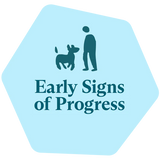It takes time and practice to learn the different social rules of another species. Everyone learns better in an environment where they feel safe. Be mindful of what your individual learner is comfortable with. You may be violating social rules of the animal kingdom without even knowing it.
- Greeting rituals are very important for establishing and maintaining close bonds throughout most of the animal kingdom. Acknowledge them when you or they enter a room the other is in. Remember to look and sound happy to see them! Follow their lead on how and for how long they like to engage in greeting.
- Interaction initiated with eye contact & a slightly higher-pitched voice increases the likelihood that your learner will follow your gaze. Practicing joint attention (when two individuals focus on the same thing after one draws the other’s attention to it) will help improve your communication and relationship. If they’re uncomfortable with eye contact, don’t force them to make it, but do reward them when they offer it.
- Try not to “loom” bent directly over your learner. Take notice if they quickly back away or show more subtle signs of discomfort such as dropping their tail or pulling their ears back. Respect when they communicate to you that you’re making them uncomfortable.
- Many dogs and cats are touched more often than they would like. Prolonged contact is typical in human-to-human interactions, but we initiate this type of physical bonding more often, and for longer durations, than our canine and feline counterparts. For many species, social bonding is as subtle as lying beside one another or choosing to engage in solitary activities near one another. Grooming through face licking or gentle nibbling also promotes social cohesion, but these close-contact interactions are generally short lasting between animals. That said, many animals have either learned to tolerate prolonged contact or have adapted to thrive off of it. Wherever your learner falls on this spectrum, it’s important to recognize and respect when they are “all done” with cuddle time even if you’re not.
Pro Tip: Keep it cool for cuddles. Recognize that your learner has a lot more fur and insulation than you do which means they’ll probably get uncomfortably warm from shared body heat faster than you will. If they often start panting before they get up and move off, there’s a good chance that’s why your cuddle sessions are being cut short.
How to Read Your Learner
Knowing your learner’s natural body language allows you to determine what words are interesting to them, whether they're engaged with you or uncomfortable with something/someone in their environment.
Which of these communicative behaviors have you noticed before in your learner?- Barking / meowing / growling / other vocalizations
- Pawing or nudging at something (a door, a bowl, a toy, etc.)
- Looking at you and then looking at something (a door, a bowl, a toy, etc.)
- Tilting their head or swiveling their ears in response to you
- Turning away / flicking their tail / refusing to make eye contact
Effective communication = healthier relationships
Be responsive. The more you respond to any attempts to communicate with you, the more likely your learner is to continue attempting to communicate with you in a meaningful way. We’re all more likely to communicate if we feel confident our message will be received, understood, and result in a desirable outcome.
Recognize and acknowledge natural communicative cues like vocalizations, bodily expressions, and referential behaviors, such as alternating their gaze between you and an object or pawing at something.
Frustration is common when there is a feeling that you can’t express yourself in a way others can understand. Show you understand by responding to their attempts to communicate. Responding to them is is different than always saying "yes." You can still establish healthy boundaries with your learner just like any other relationship.
The more responsive you are to any form of communication, the more they will try to communicate with you!
Communication is a two-way street. Our learners are constantly watching and learning how to understand us. We need to put effort into learning from and understanding them better too. Practice observing their natural communication with the Behavior Checklist.
Familiarize yourself with dog and cat body language. Remember that you have to take what their whole body is “saying” into consideration for proper interpretation. Look at their head, body, and tail. When studying their facial expressions, pay special attention to the eyes, ears, and mouth.
| DOG BODY LANGUAGE | CAT BODY LANGUAGE |
 |
 |
“Keep going!” behaviors
Playful, alert, greeting, and friendly body language in response to specific words you use is a good sign they’re paying attention and want to interact. These might be words that are most interesting to them and are great words to start teaching. If they seem ready to explore, then you’re in the clear.
“Take-it-slow” behaviors
If your learner looks nervous, stressed, uneasy, or scared, it’s time to take a break. This means something/someone in their environment is making them uncomfortable. Try introducing words, buttons, or their soundboard another time.
Learn to Read Your Learner Activities:
Behavior Checklist
Dog Body Language Chart
Cat Body Language Chart
Additional reading:
How to Read Your Dog’s Body Language
How to Interpret What Your Dog is Thinking (the Old-Fashioned Way)
Extra Credit: One of the best ways to learn animal behavior is to watch and really pay attention to how they interact with one another. Visit a dog park or watch a dog daycare feed online and pay attention to all the signaling you observe. Does your local animal shelter have a “cat room?” Volunteer and learn to read behavior at the same time!
If you have questions or feedback regarding this content, please email us at learning@fluent.pet














Leave a comment
This site is protected by hCaptcha and the hCaptcha Privacy Policy and Terms of Service apply.